Belgian Draught
The Belgian Draught, Dutch: Belgisch Trekpaard, French: Trait belge, is a Belgian breed of draught horse. It originates in the region of the Low Countries that is now central Belgium, and may also be called the Brabant after the former Province of Brabant in that area. The massive and muscular Belgian Draught is the strongest horse breed in the world.[3]
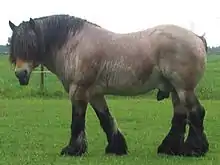 | |
| Conservation status | |
|---|---|
| Other names |
|
| Country of origin | Belgium |
| Use | farm work, heavy haulage |
| Traits | |
| Weight | |
| Height | |
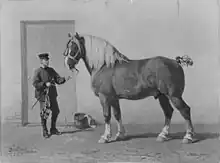

The American Belgian Draft derives from the same original stock, called the Flemish Horse, as part of the European Belgian draft horses. However, in Europe these original Flemish Horses were merged with the Brabant to create the modern Belgian Draught.[4] The horses known as American Belgian Draft in Northern America are actually the original Flemish Horses that continued to survive in its purebred shape in the Amish community and in Canada.[5][6] The European version has developed differently, it is generally shorter and more heavily built, and has a very different distribution of coat colors than the American or Flemish Horse breed.[4][7]
History
The Belgian Draught descends from the heavy farm horses of the region of the Low Countries that is now central Belgium: the Colosse de la Méhaigne[lower-alpha 1] from the valley of the Méhaigne in the area of Namur; the Gris de Nivelles et du Hainaut[lower-alpha 2], named for Hainaut region and for the city of Nivelles, now in Walloon Brabant; and the Gros de la Dendre[lower-alpha 3], named for the Dender river, from East Flanders and the area that is now Flemish Brabant.[8]: 443 [9]: 166
Documented breeding was recorded in the seventeenth century, with the first studbook founded in 1886. The first known imported Belgian to America was in the late nineteenth century. Although the crucial need for draft horses diminished after the invention of the combustion engine after World War II, the demand for the breed still continued to increase due to the want for the Belgian qualities.
Closely related breeds include the Ardennais,[10] Flemish Horse, Nederlands Trekpaard,[11][12] and Trait du Nord.[13]
Characteristics
Belgians have a thick build, are heavy in weight compared to other breeds, and have shorter legs. The average Belgian is between 16 and 17 hands tall (160 to 175 cm;[10] 64 to 68 inches). On average, they weigh anywhere between 1800 and 2200 pounds (800 to 1100 kg[10]). Belgians are normally chestnut, bay, sorrel, black, or roan in color. Their average life expectancy is between 17 and 22 years.
Temperament
Belgians are generally more on the calm side, gentle, brave, and very self-aware.
Genetic Diversity
The Belgian Draught horse has been identified as having an intermediate level of genetic diversity, and found to have relatively low levels of inbreeding. However, due to low founder diversity, the breed is identified as likely to have a potential compromise of genetic diversity in future generations.[14]
Uses
.jpg.webp)
Belgians are most commonly used for pulling carriages or sleighs, plowing, and other farm labor, as they can pull very heavy weights. At the Belgian coast the horses are used by fishermen for crab and shrimp fishing.
They are also trained and used for riding and are known to have a calm demeanor, comfortable seat, and big stride, which are all great qualities for a riding horse.
Gallery
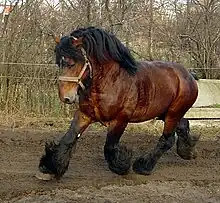 Trotting stallion.
Trotting stallion.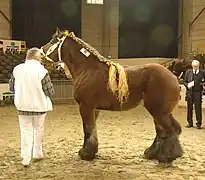 At a horse show.
At a horse show.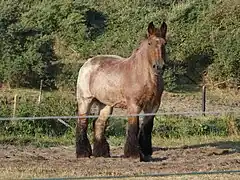 In a meadow.
In a meadow.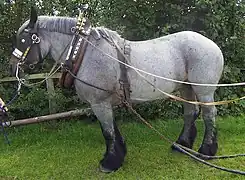 With traces.
With traces.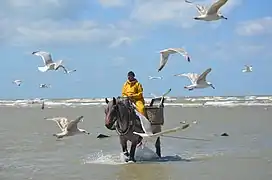 Shrimp fishing in Oostduinkerke, Belgium.
Shrimp fishing in Oostduinkerke, Belgium._2020-5.jpg.webp) Crab fishing in Brendene, Belgium.
Crab fishing in Brendene, Belgium. Herd of horses.
Herd of horses.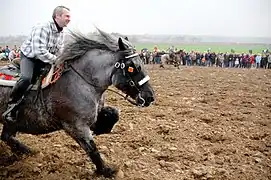 In the paardenprocessie, an event in Hakendover, Belgium.
In the paardenprocessie, an event in Hakendover, Belgium.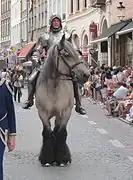 The knight of the Golden Tree-event.
The knight of the Golden Tree-event. Three abreast during a meadow-surfing event.
Three abreast during a meadow-surfing event.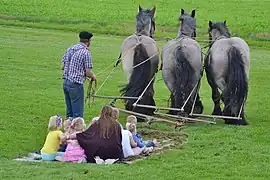 Three abreast during a meadow-surfing event.
Three abreast during a meadow-surfing event.
Notes
References
- Barbara Rischkowsky, Dafydd Pilling (editors) (2007). List of breeds documented in the Global Databank for Animal Genetic Resources, annex to The State of the World's Animal Genetic Resources for Food and Agriculture. Rome: Commission on Genetic Resources for Food and Agriculture, Food and Agriculture Organization of the United Nations. ISBN 9789251057629. Archived 23 June 2020.
- Breed data sheet: Cheval de Trait Belge / Belgium (Horse). Domestic Animal Diversity Information System of the Food and Agriculture Organization of the United Nations. Accessed April 2023.
- "Informatie over het Belgisch Trekpaard (ras standaard, geschiedenis)". www.trekpaard.net. Retrieved 2023-05-02.
- "Het Vlaams Paard vzw - Geschiedenis". www.vlaamspaard.be. Retrieved 2023-05-03.
- "Geschiedenis – Stal Talpe" (in Flemish). Retrieved 2023-05-03.
- "Vlaams paard | Steunpunt Levend Erfgoed". sle.be. Retrieved 2023-05-03.
- "Belgian Draft Horse - Brabant Drafthorse: Trekpaard.net". www.trekpaard.net. Retrieved 2023-05-03.
- Valerie Porter, Lawrence Alderson, Stephen J.G. Hall, D. Phillip Sponenberg (2016). Mason's World Encyclopedia of Livestock Breeds and Breeding (sixth edition). Wallingford: CABI. ISBN 9781780647944.
- Élise Rousseau, Yann Le Bris, Teresa Lavender Fagan (2017). Horses of the World. Princeton: Princeton University Press. ISBN 9780691167206.
- "Alles over het Belgisch trekpaard". www.bitmagazine.nl (in Dutch). Retrieved 2023-05-02.
- "Nederlands trekpaard | Bedreigd Nederlands Ras". Stichting Zeldzame Huisdierrassen (in Dutch). Retrieved 2023-05-02.
- Horses.nl, Redactie (3 April 2008). "Nederlands trekpaard". Horses (in Dutch). Retrieved 2023-05-02.
- "Parc naturel régional Scarpe-Escaut - Espace professionnel - Le Pôle Trait du Nord". 2009-06-02. Archived from the original on 2009-06-02. Retrieved 2023-05-02.
- Janssens, S.; Stinckens, A.; Schroyen, M.; Peeters, L.; De Keyser, K.; De Wael, R.; Lamberigts, C.; Luyten, T.; Ons, E.; Buys, N. (December 2010). "Genetic diversity in the Belgian Draught Horse breed as revealed by pedigree analysis and molecular marker data: Brief Note". Animal Genetics. 41: 205–206. doi:10.1111/j.1365-2052.2010.02114.x.
.jpg.webp)